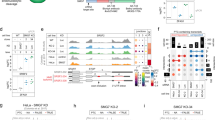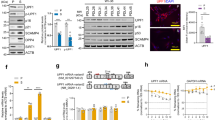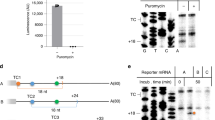Abstract
Nonsense-mediated decay (NMD) is an RNA decay pathway that downregulates aberrant mRNAs and a subset of normal mRNAs. The regulation of NMD is poorly understood. Here we identify a regulatory mechanism acting on two related UPF (up-frameshift) factors crucial for NMD: UPF3A and UPF3B. This regulatory mechanism, which reduces the level of UPF3A in response to the presence of UPF3B, is relieved in individuals harboring UPF3B mutations, leading to strongly increased steady-state levels of UPF3A. UPF3A compensates for the loss of UPF3B by regulating several NMD target transcripts, but it can also impair NMD, as it competes with the stronger NMD activator UPF3B for binding to the essential NMD factor UPF2. This deleterious effect of UPF3A protein is prevented by its destabilization using a conserved UPF3B-dependent mechanism. Together, our results suggest that UPF3A levels are tightly regulated by a post-transcriptional switch to maintain appropriate levels of NMD substrates in cells containing different levels of UPF3B.
This is a preview of subscription content, access via your institution
Access options
Subscribe to this journal
Receive 12 print issues and online access
$209.00 per year
only $17.42 per issue
Buy this article
- Purchase on SpringerLink
- Instant access to full article PDF
Prices may be subject to local taxes which are calculated during checkout






Similar content being viewed by others
References
Chang, Y.-F., Imam, J.S. & Wilkinson, M.F. The nonsense-mediated decay RNA surveillance pathway. Annu. Rev. Biochem. 76, 51–74 (2007).
Frischmeyer, P.A. & Dietz, H.C. Nonsense-mediated mRNA decay in health and disease. Hum. Mol. Genet. 8, 1893–1900 (1999).
Holbrook, J.A., Neu-Yilik, G., Hentze, M.W. & Kulozik, A.E. Nonsense-mediated decay approaches the clinic. Nat. Genet. 36, 801–808 (2004).
Mendell, J.T., Sharifi, N.A., Meyers, J.L., Martinez-Murillo, F. & Dietz, H.C. Nonsense surveillance regulates expression of diverse classes of mammalian transcripts and mutes genomic noise. Nat. Genet. 36, 1073–1078 (2004).
Chan, W.K. et al. An alternative branch of the nonsense-mediated decay pathway. EMBO J. 26, 1820–1830 (2007).
Wittmann, J., Hol, E.M. & Jack, H.M. hUPF2 silencing identifies physiologic substrates of mammalian nonsense-mediated mRNA decay. Mol. Cell. Biol. 26, 1272–1287 (2006).
Weischenfeldt, J. et al. NMD is essential for hematopoietic stem and progenitor cells and for eliminating by-products of programmed DNA rearrangements. Genes Dev. 22, 1381–1396 (2008).
Czaplinski, K. et al. The surveillance complex interacts with the translation release factors to enhance termination and degrade aberrant mRNAs. Genes Dev. 12, 1665–1677 (1998).
Kashima, I. et al. Binding of a novel SMG-1-Upf1-eRF1-eRF3 complex (SURF) to the exon junction complex triggers Upf1 phosphorylation and nonsense-mediated mRNA decay. Genes Dev. 20, 355–367 (2006).
Ivanov, P.V., Gehring, N.H., Kunz, J.B., Hentze, M.W. & Kulozik, A.E. Interactions between UPF1, eRFs, PABP and the exon junction complex suggest an integrated model for mammalian NMD pathways. EMBO J. 27, 736–747 (2008).
Singh, G., Rebbapragada, I. & Lykke-Andersen, J. A competition between stimulators and antagonists of Upf complex recruitment governs human nonsense-mediated mRNA decay. PLoS Biol. 6, e111 (2008).
Gehring, N.H., Neu-Yilik, G., Schell, T., Hentze, M.W. & Kulozik, A.E. Y14 and hUpf3b form an NMD-activating complex. Mol. Cell 11, 939–949 (2003).
Kim, V.N., Kataoka, N. & Dreyfuss, G. Role of the nonsense-mediated decay factor hUpf3 in the splicing-dependent exon-exon junction complex. Science 293, 1832–1836 (2001).
Lykke-Andersen, J., Shu, M.D. & Steitz, J.A. Human Upf proteins target an mRNA for nonsense-mediated decay when bound downstream of a termination codon. Cell 103, 1121–1131 (2000).
Serin, G., Gersappe, A., Black, J.D., Aronoff, R. & Maquat, L.E. Identification and characterization of human orthologues to Saccharomyces cerevisiae Upf2 protein and Upf3 protein (Caenorhabditis elegans SMG-4). Mol. Cell. Biol. 21, 209–223 (2001).
Wang, P.J. X chromosomes, retrogenes and their role in male reproduction. Trends Endocrinol. Metab. 15, 79–83 (2004).
Kim, Y.K., Furic, L., Desgroseillers, L. & Maquat, L.E. Mammalian Staufen1 recruits Upf1 to specific mRNA 3′ UTRs so as to elicit mRNA decay. Cell 120, 195–208 (2005).
Kunz, J.B., Neu-Yilik, G., Hentze, M.W., Kulozik, A.E. & Gehring, N.H. Functions of hUpf3a and hUpf3b in nonsense-mediated mRNA decay and translation. RNA 12, 1015–1022 (2006).
Kafri, R., Levy, M. & Pilpel, Y. The regulatory utilization of genetic redundancy through responsive backup circuits. Proc. Natl. Acad. Sci. USA 103, 11653–11658 (2006).
Tarpey, P.S. et al. Mutations in UPF3B, a member of the nonsense-mediated mRNA decay complex, cause syndromic and nonsyndromic mental retardation. Nat. Genet. 39, 1127–1133 (2007).
Schell, T. et al. Complexes between the nonsense-mediated mRNA decay pathway factor human UPF1 (up-frameshift protein 1) and essential nonsense-mediated mRNA decay factors in HeLa cells. Biochem. J. 373, 775–783 (2003).
Ohnishi, T. et al. Phosphorylation of hUPF1 induces formation of mRNA surveillance complexes containing hSMG-5 and hSMG-7. Mol. Cell 12, 1187–1200 (2003).
de Moor, C.H., Meijer, H. & Lissenden, S. Mechanisms of translational control by the 3′ UTR in development and differentiation. Semin. Cell Dev. Biol. 16, 49–58 (2005).
Kadlec, J., Izaurralde, E. & Cusack, S. The structural basis for the interaction between nonsense-mediated mRNA decay factors UPF2 and UPF3. Nat. Struct. Mol. Biol. 11, 330–337 (2004).
Koonin, E.V. Paralogs and mutational robustness linked through transcriptional reprogramming. Bioessays 27, 865–868 (2005).
Turner, J.M. Meiotic sex chromosome inactivation. Development 134, 1823–1831 (2007).
Zetoune, A.B. et al. Comparison of nonsense-mediated mRNA decay efficiency in various murine tissues. BMC Genet. 9, 83 (2008).
Solomon, K.S. & Fritz, A. Concerted action of two dlx paralogs in sensory placode formation. Development 129, 3127–3136 (2002).
Rudnicki, M.A., Braun, T., Hinuma, S. & Jaenisch, R. Inactivation of MyoD in mice leads to up-regulation of the myogenic HLH gene Myf-5 and results in apparently normal muscle development. Cell 71, 383–390 (1992).
Gray, T.A. et al. Concerted regulation and molecular evolution of the duplicated SNRPB′/B and SNRPN loci. Nucleic Acids Res. 27, 4577–4584 (1999).
Peters, H. et al. Pax1 and Pax9 synergistically regulate vertebral column development. Development 126, 5399–5408 (1999).
Toresson, H. & Campbell, K. A role for Gsh1 in the developing striatum and olfactory bulb of Gsh2 mutant mice. Development 128, 4769–4780 (2001).
Stefan, M., Portis, T., Longnecker, R. & Nicholls, R.D. A nonimprinted Prader-Willi syndrome (PWS)-region gene regulates a different chromosomal domain in trans but the imprinted pws loci do not alter genome-wide mRNA levels. Genomics 85, 630–640 (2005).
Han, J. et al. Posttranscriptional crossregulation between Drosha and DGCR8. Cell 136, 75–84 (2009).
Gehring, N.H. et al. Exon-junction complex components specify distinct routes of nonsense-mediated mRNA decay with differential cofactor requirements. Mol. Cell 20, 65–75 (2005).
Bühler, M., Steiner, S., Mohn, F., Paillusson, A. & Muhlemann, O. EJC-independent degradation of nonsense immunoglobulin-mu mRNA depends on 3′ UTR length. Nat. Struct. Mol. Biol. 13, 462–464 (2006).
Medghalchi, S.M. et al. Rent1, a trans-effector of nonsense-mediated mRNA decay, is essential for mammalian embryonic viability. Hum. Mol. Genet. 10, 99–105 (2001).
Gudikote, J.P. & Wilkinson, M.F. T-cell receptor sequences that elicit strong down-regulation of premature termination codon-bearing transcripts. EMBO J. 21, 125–134 (2002).
Neu-Yilik, G. et al. Splicing and 3′ end formation in the definition of nonsense-mediated decay-competent human β-globin mRNPs. EMBO J. 20, 532–540 (2001).
Mendell, J.T., ap Rhys, C.M. & Dietz, H.C. Separable roles for rent1/hUpf1 in altered splicing and decay of nonsense transcripts. Science 298, 419–422 (2002).
Palacios, I.M., Gatfield, D., St. Johnston, D. & Izaurralde, E. An eIF4AIII-containing complex required for mRNA localization and nonsense-mediated mRNA decay. Nature 427, 753–757 (2004).
Nott, A., Le Hir, H. & Moore, M.J. Splicing enhances translation in mammalian cells: an additional function of the exon junction complex. Genes Dev. 18, 210–222 (2004).
Chamieh, H., Ballut, L., Bonneau, F. & Le Hir, H. NMD factors UPF2 and UPF3 bridge UPF1 to the exon junction complex and stimulate its RNA helicase activity. Nat. Struct. Mol. Biol. 15, 85–93 (2008).
Acknowledgements
We thank J. Lykke-Andersen (University of Colorado) for several independent aliquots of antibodies against UPF1, UPF2, UPF3A and UPF3B, as well as the MS2-UPF1 and MS2-UPF2 constructs; L. Maquat (University of Rochester) for the T7-UPF2 constructs; M. Hentze (European Molecular Biology Labortaory, Heidelberg), A. Kulozik (University of Heidelberg,) and N. Gehring (University of Heidelberg) for human UPF3A and UPF3B constructs; M. Moore (University of Massachusetts) and A.-B. Shyu (University of Texas-Houston) for their polysome protocols; C. Shoubridge and L. Vandeleur (University of Adelaide) for culturing Epstein-Barr virus–immortalized B cell lines; and C. Schwartz and A. Srivastava (JC Self Research Institute of Human Genetics) for sharing the lymphoblastoid cell lines from family 1. Finally, we thank the many investigators whose publications inspired this work; we apologize that there is insufficient space to acknowledge them and reference all of their relevant publications. This work was funded by the US National Institutes of Health grant GM058595 (M.F.W.) and an Australian National Health and Medical Research Council grant (J.G.).
Author information
Authors and Affiliations
Contributions
W.-K.C. and M.F.W. designed the experiments; L.S.N. and J.G. provided samples for the experiments; H.L.H. produced recombinant proteins and performed in vitro binding assays; W.-K.C. carried out the experiments with the help of A.D.B. and L.H; W.-K.C. and M.F.W. wrote the manuscript with the help of L.S.N., J.G., A.D.B. and L.H.
Corresponding author
Supplementary information
Supplementary Text and Figures
Supplementary Figures 1–10 and Supplementary Table 1 (PDF 807 kb)
Rights and permissions
About this article
Cite this article
Chan, WK., Bhalla, A., Le Hir, H. et al. A UPF3-mediated regulatory switch that maintains RNA surveillance. Nat Struct Mol Biol 16, 747–753 (2009). https://doi.org/10.1038/nsmb.1612
Received:
Accepted:
Published:
Issue Date:
DOI: https://doi.org/10.1038/nsmb.1612
This article is cited by
-
CFTR mRNAs with nonsense codons are degraded by the SMG6-mediated endonucleolytic decay pathway
Nature Communications (2022)
-
Nonsense-mediated RNA decay and its bipolar function in cancer
Molecular Cancer (2021)
-
Assessment of differentially methylated loci in individuals with end-stage kidney disease attributed to diabetic kidney disease: an exploratory study
Clinical Epigenetics (2021)
-
Microsatellite instability in cancer: a novel landscape for diagnostic and therapeutic approach
Archives of Toxicology (2020)
-
Differential alternative splicing regulation among hepatocellular carcinoma with different risk factors
BMC Medical Genomics (2019)



